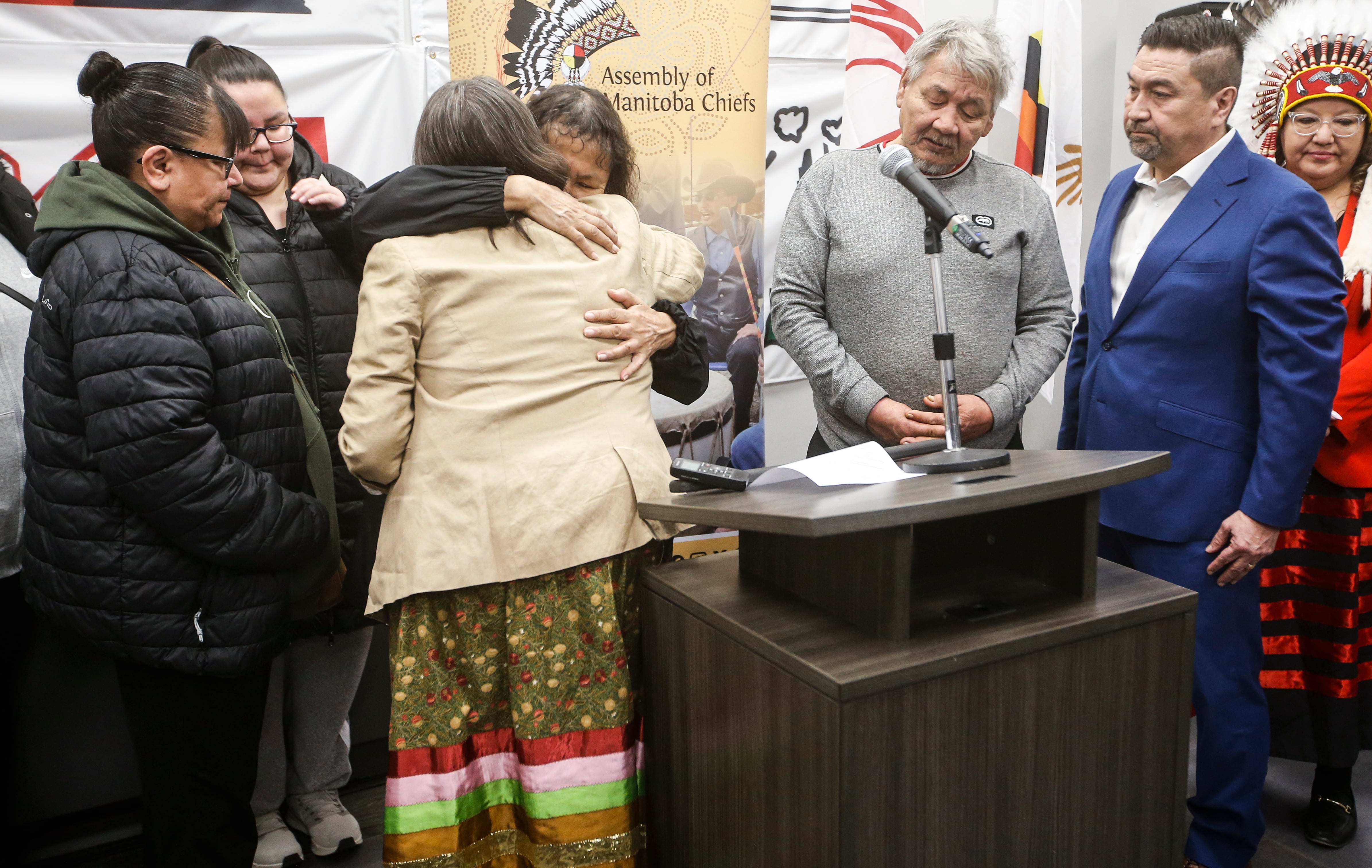Theresa Shingoose, mother of Ashlee Shingoose who has been identified as the fourth victim of a serial killer, is comforted by Thelma Morriseau as husband Albert looks on at an Assembly of Manitoba Chiefs news conference in Winnipeg, on March 27.JOHN WOODS/The Canadian Press
Ashlee Shingoose’s parents remember their quiet and caring daughter moving to Winnipeg from their northern Manitoba home in St. Theresa Point First Nation nearly a decade ago. She wanted to make a better life for herself and her three children.
When she went missing in 2022, within months, her family was certain that she was one of four women murdered and disposed of in landfills by a serial killer in the city.
“But nobody back then would listen to us,” Albert Shingoose, Ashlee’s father, told The Globe and Mail.
Mr. Shingoose and his wife, Theresa, travelled from their remote fly-in community repeatedly to look for their daughter, at times roaming the streets of Winnipeg until the wee hours of the morning.
The Shingoose family met with police multiple times after Ashlee disappeared, trying to persuade them that she was the unnamed victim of the man arrested in May of 2022. They had their DNA collected to match with evidence found in and around the crime scene, but Winnipeg police said a positive match for Ashlee Shingoose could not be made.
Last summer, by the time the trial began for the now-convicted murderer, police had only been able to identify three of the victims: 39-year-old Morgan Harris, 26-year-old Marcedes Myran and 24-year-old Rebecca Contois.
Families and supporters of the identified three women, along with First Nations elders, had given a spirit name to the only victim that police could not identify: Mashkode Bizhiki’ikwe, meaning Buffalo Woman in Anishinaabemowin.
The Shingoose family, however, was still convinced of Ashlee’s connection to the murders. They flew to Winnipeg over and over again to attend the trial. “We sat in court. We listened to the verdict. We listened to the sentencing,” Mr. Shingoose said.
“We always believed our daughter was Buffalo Woman.”
This week, three years later, police confirmed for the first time that Ashlee Christine Shingoose is Buffalo Woman, whose remains they believe are located at the Brady Road landfill, operated by the City of Winnipeg.
Homicide investigators met with the Shingoose family at St. Theresa Point to tell them the news on Tuesday, holding a press conference with First Nations leaders the following day, where Manitoba Premier Wab Kinew promised to fund a new landfill search for Ashlee. The province is continuing to search a separate landfill for two of the other victims, Ms. Harris and Ms. Myran, some of whose remains were successfully located earlier this month at the site.
It was a DNA sample from a previously untested pair of pants that led police to confirm Ms. Shingoose’s identity.
Deputy Chief Cam Mackid said Winnipeg police seized far too many items to realistically test them all for DNA analysis. The pants, he said, were only brought to the investigators’ attention this past December after a prison interview with the killer, Jeremy Skibicki, who was sentenced to life in August. Previous DNA samples for the unnamed victim were not matched to anyone, he added.
Mr. and Ms. Shingoose could not attend the Wednesday police announcement because of bad weather. But on Thursday, they flew to Winnipeg once again, this time with what they described as “tears of hope.”
“It’s too hard to lose your daughter, not knowing where she is,” said Theresa Shingoose at a press conference arranged by the Assembly of Manitoba Chiefs, the organization representing 63 First Nations across the province.
Overcome with emotion, Ms. Shingoose stood next to her oldest daughter and two granddaughters as she spoke. The family offered tobacco as a sign of gratitude to the First Nations elders, including Thelma Morrisseau, who gave Ashlee the name Buffalo Woman and fought for her dignity.
“We wanted her to have a name because she deserved it, because she was important, because whoever her family was had loved her,” Ms. Morrisseau said.
“The landfill is not a burial ground for anybody. We’re not garbage. Nobody is garbage,” Mr. Shingoose, raising his fist in the air, told reporters. “I need your words. I need your voices – speak up.”
Later on Thursday, the parents met with The Globe. “We’re talking with you because we want you to know who our daughter was and the difficult circumstances that led her to this point,” Mr. Shingoose said, shortly before he attended a private ceremony with Mr. Kinew, where they lit a sacred fire in Ashlee’s honour.
The parents said Ashlee had moved out of their St. Theresa Point home largely because of their living conditions. With a lack of housing in the community, the Shingoose family shares a small bungalow with more than 10 people, some sleeping on a single couch and in their kitchen.
There are roughly 300 families on a waiting list for housing in Mr. Shingoose’s First Nation, which the most recent figures from Ottawa show has an on-reserve population of about 4,000 people.
“When Ashlee moved out, she was a committed mother,” Ms. Shingoose said. “But she got involved with the wrong crowd and began to drink and take drugs.”
Mr. and Ms. Shingoose had to take over the care of their granddaughters, as Ashlee sought help for her addictions and struggled with homelessness. “That’s when she was murdered,” Mr. Shingoose said, “because that killer preyed on her when she was most vulnerable.”
The post Ashlee Shingoose, victim of Winnipeg serial killer, remembered as quiet and caring daughter appeared first on World Online.

